The Complete Guide to Driveline Bat Speed Trainers
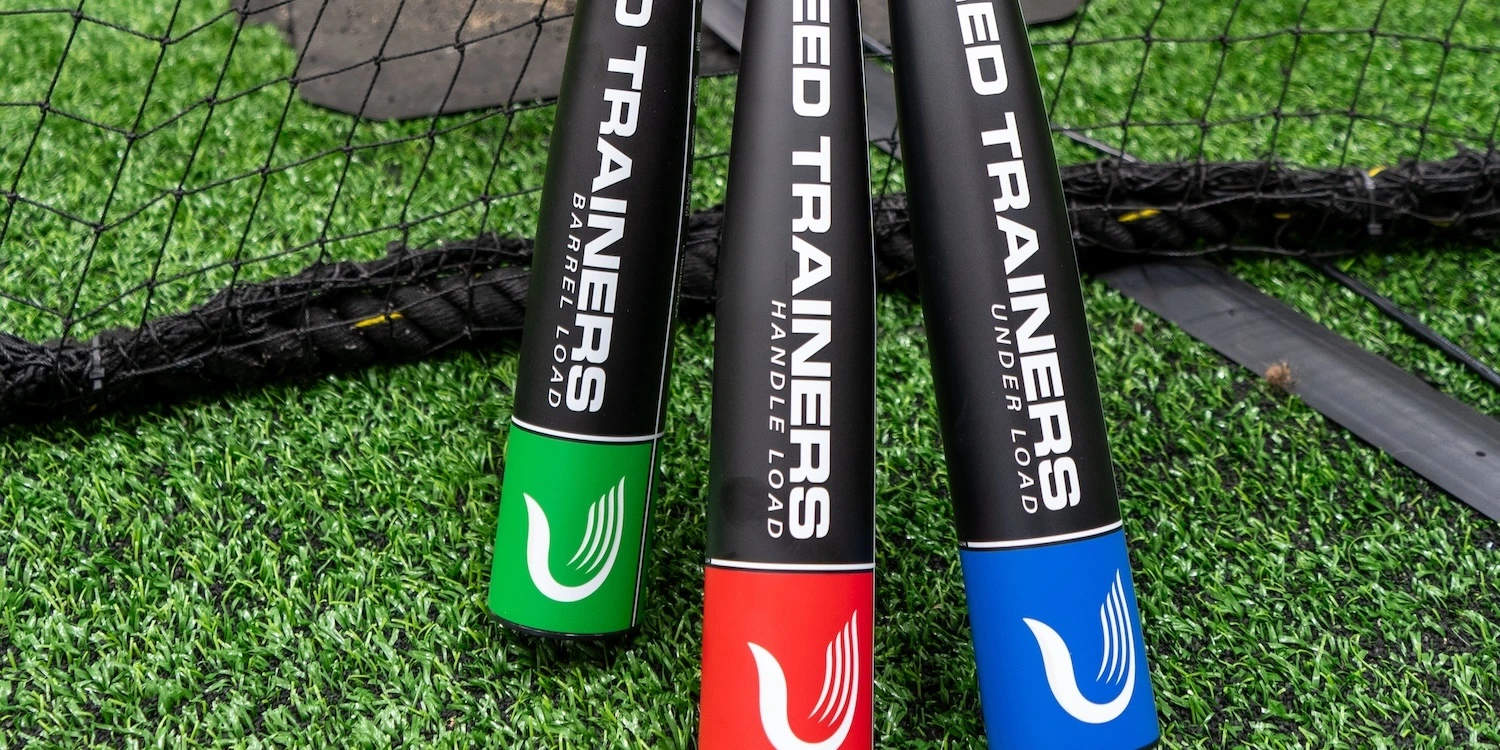
The quest for offensive success in baseball ultimately comes down to consistently producing high-quality contact. At the heart of this lies bat speed – the fundamental driver of exit velocity and, consequently, offensive performance. Research by Dr. Alan Nathan demonstrates that for every 1 mph increase in bat speed, exit velocity increases by approximately 1.2 mph. This increase translates to an additional 4-7 feet of carry distance on perfectly hit balls, which can turn warning track outs into doubles or home runs.
Exit velocity is critical because it directly correlates with offensive success. Here’s how performance metrics like expected wOBA, batting average, and slugging percentage, on average, improve at different exit velocity thresholds at the MLB level:
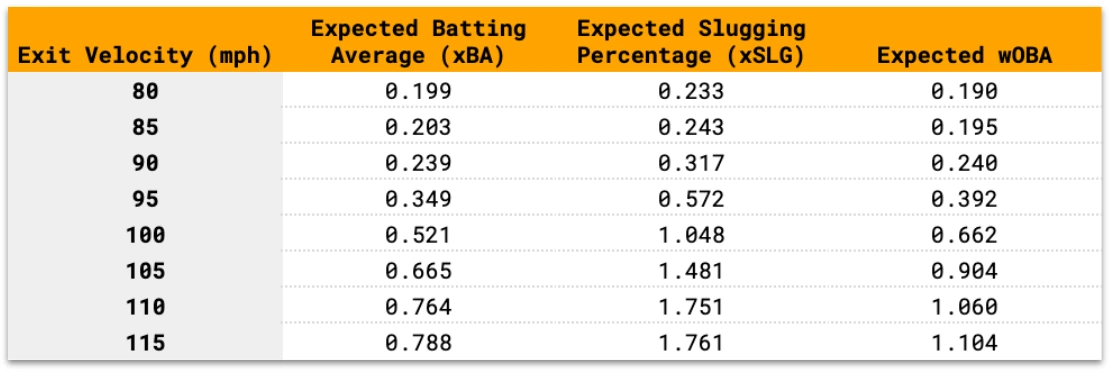
This direct relationship between bat speed and offensive success underscores why sophisticated bat speed development is crucial for modern hitters. Driveline’s bat speed training system combines cutting-edge biomechanics research with practical application, built on three core principles:
- Specificity of training – implements must match their intended training purpose
- Variable practice – tools that challenge different aspects of the swing
- Immediate feedback – equipment that provides clear, actionable feedback on movement patterns, bat path and contact quality.
Understanding Driveline Bat Speed Trainers
With this clear relationship between bat speed and offensive success established, let’s examine the tools designed to develop this crucial skill. The cornerstone of Driveline’s bat speed development system consists of three specialized implements: the Barrel Load, Handle Load, and Underload bats. Each trainer is precisely engineered to target specific aspects of bat speed development while maintaining swing characteristics that transfer to in game performance. The Barrel Load and Handle Load are designed at +20% of standard bat weight, while the Underload is -20%, ensuring optimal training effects that translate to increased exit velocities in game situations.
The Physics:
Before we dive into specific applications, let’s break down two key physical principles behind each implement’s effectiveness: Moment of Inertia (MOI) and impulse. Understanding these principles isn’t just academic—it’s essential for appreciating how using these tools as constraints can transform your swing.
MOI determines how weight distribution affects the ease or difficulty of rotating a bat. You can feel this principle in action every time you pick up a bat—weight concentrated in the barrel (higher MOI) requires more rotational force to accelerate, while weight closer to your hands (lower MOI) allows for quicker rotation but demands more precise control.
Impulse—the product of force and time—explains how hitters generate momentum in their swing. Our research shows that elite hitters optimize this force-time relationship in different ways. Some apply massive force over a shorter time window, while others maintain moderate force over a longer duration. Both can be effective, but understanding these dynamics allows you, as a coach or hitter, to optimize training economy to drive desired adaptations over time.
The Training Arsenal: Understanding Each Tool's Role
Barrel-Loaded Bat: Emphasizing Peak Force Production and Sequencing
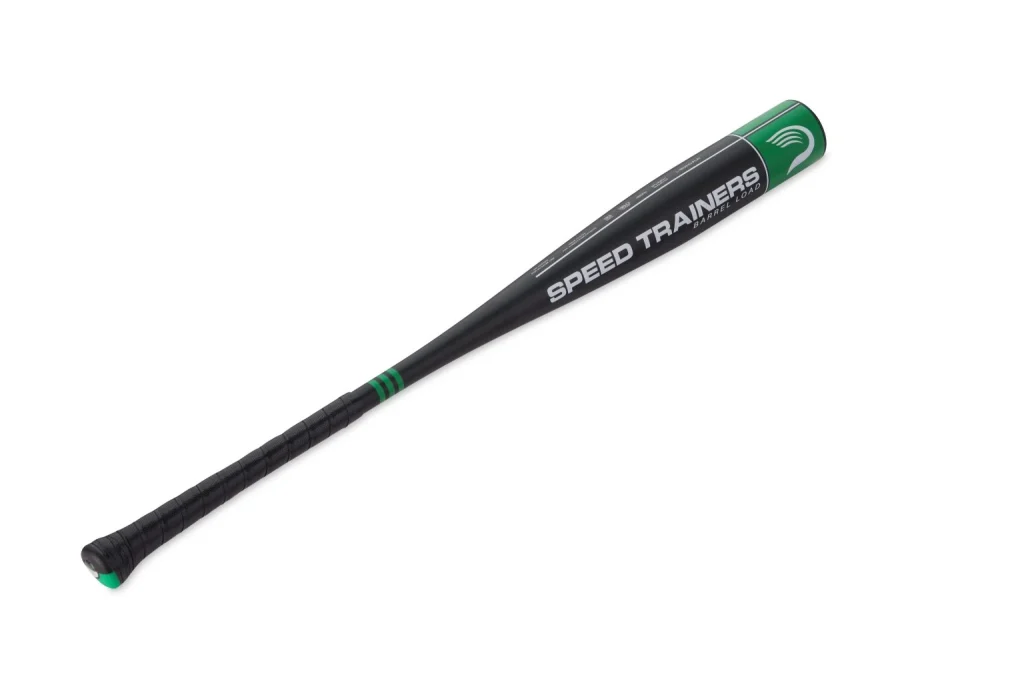
When you first pick up our barrel-loaded bat, you’ll immediately notice the weight concentrated in the barrel, this implement features a significantly higher MOI compared to a game bat, requiring greater rotational force to swing effectively. This increased MOI challenges a hitter’s ability to maximize impulse through higher peak force production. By concentrating weight in the barrel, this implement promotes efficient lower-body and torso engagement (using the bigger, more proximal segments effectively) while encouraging optimal timing and usage of hip-shoulder separation. The higher MOI forces hitters to create more force over the same time period to achieve game-like bat speeds, making it particularly effective for hitters who struggle with early hand activation or upper body dominant sequencing issues. When you sequence efficiently, the bat rewards you with explosive barrel speed – it feels “easy” to swing. When you don’t, you feel it immediately, making this tool invaluable for developing consistent, powerful mechanics.
Handle-Loaded Bat: Extending Force Application Duration and Directional Control
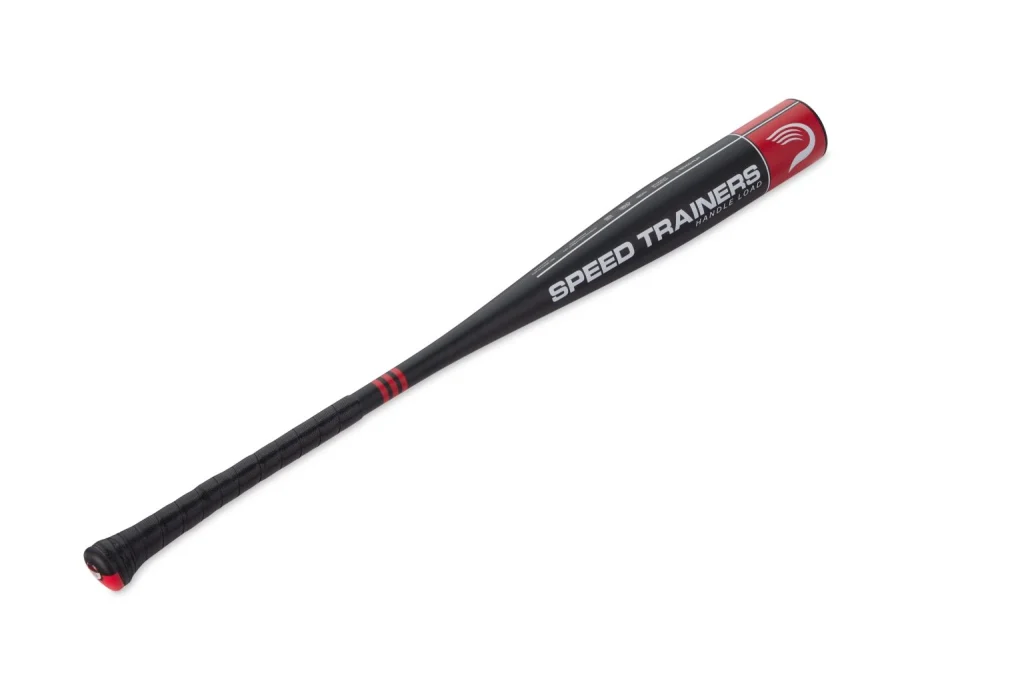
While matching the +20% weight increase of the barrel-loaded bat, the handle-loaded bat’s MOI is much closer to a game bat due to its weight distribution closer to the hands. This design creates a unique impulse training effect by allowing hitters to maintain force application for a longer duration during the swing. The weight placement provides immediate feedback on the relationship between rotational acceleration and barrel direction – if a hitter sequences improperly or misdirects the barrel, they’ll feel an immediate loss of efficiency and speed. This helps hitters understand how to combine rotational acceleration with proper barrel direction, leading to more efficient, connected movements translating hand speed into bat speed at contact.
When hitters learn to accelerate earlier and maintain force application longer while controlling barrel direction, they create more consistent hard contact, evidenced by higher average exit velocities even on mishit balls. The handle-loaded weight distribution allows hitters to feel the difference between arm-dominant swings leading to bat path issues and efficiently sequenced movements that maintain speed and direction through contact. Many hitters discover they can create significantly more bat speed at contact when they learn to start their acceleration earlier allowing them to release or deliver the barrel at the right time—a skill this tool naturally encourages.
Underload Bat: Developing Quick-Twitch Recruitment, Force Application in Shorter Windows and Adjustability
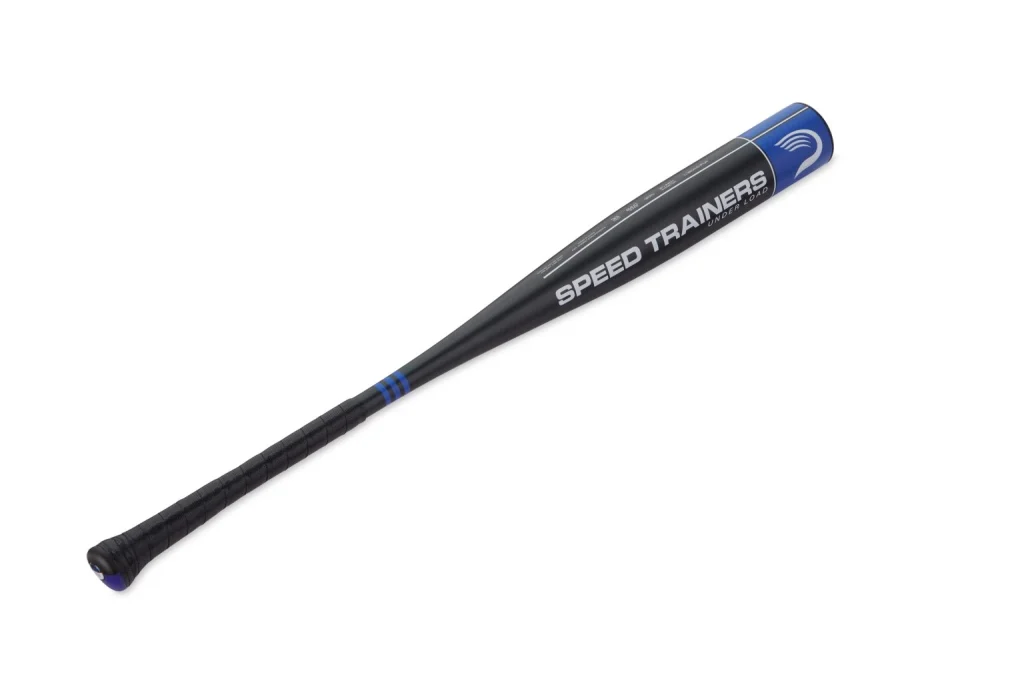
With both reduced weight and lower MOI compared to a game bat, this implement trains a different aspect of impulse – the ability to generate force quickly in shorter time windows. Beyond just pure speed development, the underload bat’s characteristics demand precise control at higher velocities. The reduced MOI allows for faster rotational movements and quicker force application, making it especially valuable for developing adjustability to different pitch types and locations. While the under load helps hitters develop speed, hitters with high bat speeds particularly benefit from this tool as well. It helps them learn to harness and direct their speed effectively. Rather than just training pure top end velocity, the underload can teach hitters how to sequence efficiently while maintaining control at elevated speeds – a crucial skill for high-level performance in game.
Practical Applications & Common Swing Flaws
Understanding how each bat speed trainer’s unique MOI and impulse characteristics can address specific swing flaws helps coaches and players select the right tool for their development needs.
Push Pattern: Early Hand Activation
The push pattern occurs when a hitter’s hands and arms begin accelerating before and faster than the torso, leading to decreased energy transfer and lower bat speeds. The barrel-loaded bat, with its high MOI, is particularly effective at addressing this issue. The increased rotational resistance makes it nearly impossible to “push” the barrel with the hands alone, forcing proper sequencing from the ground up. When a hitter tries to push with their hands, the bat’s high MOI provides immediate feedback through a severe loss of speed and barrel control.
Bat Drag and Early Acceleration Issues
Bat drag, often seen in younger or weaker hitters, occurs when the torso begins rotating forward but the hands and barrel lag behind, creating disconnection. The handle-loaded bat helps address this issue by allowing hitters to feel proper connection through its more balanced over loaded MOI profile. With the weight concentrated near the hands, hitters can focus on initiating rotation and directing the barrel properly in space. This weight distribution provides immediate feedback on the relationship between rotational acceleration and barrel direction – if a hitter sequences improperly or misdirects the barrel, they’ll feel an immediate loss of efficiency and speed. The handle load teaches hitters to combine rotational acceleration with proper barrel direction, leading to more efficient, connected movements.
Speed Control and Sequencing Efficiency
The underload bat’s reduced weight and MOI create a unique training stimulus that extends beyond pure bat speed development. While it allows for maximum swing speeds, this very characteristic can expose inefficient movement patterns. At higher speeds, any sequencing issues or path inefficiencies become magnified – the lighter weight actually demands more precise control. This makes the underload particularly valuable for high bat speed hitters, who must learn to harness and control their speed rather than simply swing faster. The implement forces hitters to move more efficiently to “control” the barrel at much higher speeds, making it an excellent tool for developing both speed and precision.
Year-Round Implementation Strategy
Understanding how to implement the complete set of bat speed trainers is crucial for optimal results. Following established principles in motor learning and skill acquisition, Research by Schmidt & Lee (2019) emphasizes that specificity in training enhances both skill retention and performance under pressure. Training adaptations have the highest rate of transfer when practiced in environments that closely mimic the demands of competition.
Specificity is critical, but tools like Driveline’s Bat Speed Trainers stand out because they are adaptable to all stages of training—from low-context early offseason drills to high-context live BP closer to the season. This versatility ensures that the skills developed using these tools can seamlessly transfer to game situations. While each bat has specific benefits, they work together as a comprehensive system, with all three implements being valuable throughout the training year.
Early Offseason: Building Foundation and Workload Capacity
During this phase, the primary focus is on building both efficient movement patterns and the workload capacity needed for high-intent training. While training often begins in controlled environments like tees and flips, this is more about managing overall stress than limiting tool selection. All three implements play important roles:
- Barrel-loaded bats target peak force application and help establish efficient sequencing
- Handle-loaded bats develop early force application patterns and barrel direction
- Underload bats maintain quick-twitch capabilities and the ability to produce force in tighter windows
The early off-season’s distance from competition allows for more blocked practice and higher overall volume, though at lower intensities. Even in this phase, hitters can and should progress to higher-speed, more game-like environments as their capacity develops. It’s always good to challenge yourself with game like speeds in training, even early in the offseason it’s a way to heat check and stress test changes you’ve started implementing.
Mid to Late Off-Season: Progressive Game Integration and blend to competition
As players build capacity and the season approaches, the primary shift is not in which implements are used, but rather in how they’re used. The training environment becomes increasingly game-like, with a gradual shift from blocked to more randomized practice. This progression applies to all three bat speed trainers, with each continuing to serve its specific purpose for the individual hitter’s needs, but within more challenging contexts.
In-Season Implementation: Maintaining and Building Upon Off-Season Gains
During the competitive season, bat speed training remains valuable but requires careful management of volume and timing. The fundamental principles of each implement remain unchanged – the barrel load still targets peak force production, the handle load focuses on extended force application, and the underload develops quick-twitch capabilities. However, the implementation strategy shifts to account for:
Game Schedule and Recovery
Training volume and intensity must be strategically planned around game schedules and travel. High-intent bat speed work should be programmed with adequate recovery time before games. A player’s competitive workload (number of at-bats, recent game schedule, travel demands, off field stressors, etc.) directly influences their capacity for additional training stimulus.
Maintenance vs. Development
While the primary in-season focus is maintaining offseason gains, continued development is possible with proper programming. Keys to in-season development include:
- Careful monitoring of fatigue and recovery markers – you need to sleep and eat well to recover.
- Strategic placement of higher-intent sessions during lighter game weeks
- Reduced overall volume while maintaining quality of movement
- Adjusting training intensity based on game performance and feel
- Continued training in the weight room, built with your game workload, high-intent swing sessions, and individual strengths and weaknesses in mind.
Success Indicators and Key Performance Outcomes
Success with the bat speed training system can be measured through several key indicators:
Bat Speed Improvements
Self explanatory. Set a baseline in whatever environment you choose, and periodically retest in that same environment tracking your progress over time. If bat speed is increasing, you’re on the right track. Would recommend setting the baseline vs game speeds if possible (Straight fastball off the machine) but you can do so in front toss or vs BP, just be sure to track your progress overtime in a similar environment. Worth noting, in terms of specificity and transfer of training, gains made in easier, more controlled environments wont necessarily directly translate, but that’s why stress testing at high speeds is important throughout off-season progressions.
Exit Velocity Improvements
Exit velocity, peak, 90th percentile and average, represents the ultimate measure of bat speed training success. At the end of the day we want to increase bat speed to hit the ball harder. The linear relationship between bat speed and exit velocity means that improvements in bat speed directly translate to harder hit balls, which translates to better overall offensive performance. This relationship extends beyond just perfect contact – increased bat speed expands a hitter’s margin for error with timing and contact quality, meaning even mishits are hit harder. When we improve a hitter’s bat speed, we’re effectively:
- Increasing their peak exit velocity potential
- Raising their exit velocity floor on mishits
- Expanding their “sweet spot” for hard hit balls
- Creating more valuable batted ball events across all contact types
This is why bat speed development is so crucial – it’s not just about swinging faster, it’s about creating more damage on contact throughout a hitter’s batted ball distribution. A comprehensive bat speed training program should result in measurable improvements in both bat speed and exit velocity metrics, indicating successful transfer of training to game performance.
Getting Started
- Get yourself some bat speed trainers
- Begin with movement pattern and/or biomechanical assessments to identify any existing swing characteristics that need addressing
- Establish baseline metrics for tracking progress
- Bat sensors are your friend here
- Launch monitors: HitTrax, Trackman, Rapsodo, etc. are incredibly helpful
- Can always revert to a radar gun if needed (be mindful of cosine error – point the gun where you’re hitting the ball)
- Start in more controlled environments while learning proper implement use
- Focus on quality of movement/output before increasing volume or environmental complexity (Time of year depending – Don’t wait too long to get your off-season started)
Progressive Development
- Advance training environments based on movement quality and intent level
- Maintain proper work-to-rest ratios based on training phase
- Monitor recovery and adaptation rates
- Adjust volume and intensity based on competition schedule and overall workload
Conclusion
The Driveline bat speed training system provides a comprehensive approach to developing some of hitting’s most crucial components. By understanding the science behind each implement’s design – from MOI to impulse – and their specific applications, players can systematically improve their bat speed, leading to better exit velocities and ultimately, improved offensive performance. Success with these implements comes from proper implementation throughout the year, respecting both their specific purposes and the broader principles of motor learning and skill acquisition.
Comment section